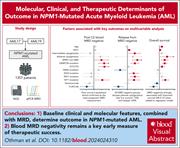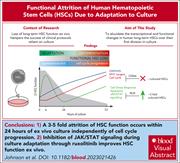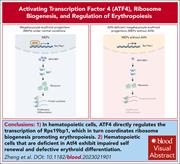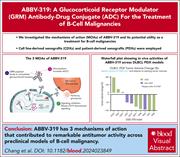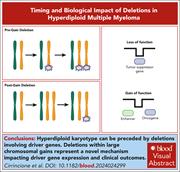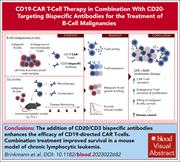Issue Archive
Table of Contents
BLOOD COMMENTARIES
PLENARY PAPER
Iron, hemochromatosis genotypes, and risk of infections: a cohort study of 142 188 general population individuals
CME
Clinical Trials & Observations
In this month’s CME article, a Plenary Paper, Mottelson et al investigated the risk of infection associated with iron and ferritin levels, transferrin saturation (TSAT), and hemochromatosis genotypes. Patients with homozygous HFE C282Y had increased infections, even with normal iron, TSAT, and ferritin levels. Patients who did not have hemochromatosis but had elevated TSAT also had an increased risk of infection. Surprisingly, patients with TSAT of <5% also had increased infections, but this was not correlated with low ferritin, suggesting this might reflect chronic inflammation. This puzzling constellation has important implications for the role of phlebotomy in patients with HFE-related hemochromatosis and emphasizes the importance of treating iron deficiency.
BLOOD SPOTLIGHT
Momelotinib for the treatment of myelofibrosis
In this Blood Spotlight, Prithviraj Bose provides a review of momelotinib, a JAK inhibitor approved in September 2023 by the US Food and Drug Administration, for the treatment of anemic patients with myelofibrosis. In addition to inhibiting JAK1, JAK2, and tyrosine kinase 2, momelotinib also inhibits the bone morphogenic protein receptor, downregulating hepcidin production and improving iron mobilization and the stimulation of erythropoiesis. This feature distinguishes it from other approved JAK inhibitors. In clinical trials, momelotinib improved splenomegaly, symptoms, and anemia, even in patients with thrombocytopenia.
CLINICAL TRIALS AND OBSERVATIONS
Molecular, clinical, and therapeutic determinants of outcome in NPM1-mutated AML
Clinical Trials & Observations
Patients with NPM1-mutated (NPM1mut) acute myeloid leukemia (AML) have a favorable prognosis, but relapses occur in up to 50% of patients. Postinduction measurable residual disease (MRD) predicts outcome, as do FLT3 internal tandem duplication and adverse cytogenetics. Othman and colleagues studied 1357 patients with NPM1mut AML in 2 large prospective trials to assess the impact of baseline clinical and molecular features, postinduction MRD, and treatment intensity on outcomes. The authors report secondary mutations associated with worse outcome but cannot identify a particular subgroup, except for patients with adverse cytogenetics, that benefits from allografting in first remission.
HEMATOPOIESIS AND STEM CELLS
Adaptation to ex vivo culture reduces human hematopoietic stem cell activity independently of the cell cycle
Culture of long-term hematopoietic stem cells (LT-HSCs) is associated with a loss of stem cell potential, a change that is thought to occur as the result of in vitro cell division. Johnson et al used single-cell RNA sequencing to characterize the gene expression changes that occur in this process and showed that, contrary to the accepted dogma, the loss of LT-HSC function is independent of cell-cycle progression. The authors further demonstrated that inhibition of early JAK/STAT signaling improved LT-HSC repopulation function.
The ATF4-RPS19BP1 axis modulates ribosome biogenesis to promote erythropoiesis
Zheng and colleagues examined the role of activating transcription factor 4 (ATF4) in the maintenance of fetal and adult hematopoietic stem cells (HSCs) through cell-type–specific murine cells with conditional knockout of Atf4 in a variety of cell types. Depletion of Atf4 in the bone marrow niche did not affect hematopoiesis, but Atf4-deficient HSCs had a profound defect in erythroid maturation, which led to hypoplastic anemia. The authors demonstrated that ATF4 regulates Rps19bp1 transcription, which promotes 40 S ribosomal subunit assembly, coordinating ribosome biogenesis and promoting erythropoiesis.
IMMUNOBIOLOGY AND IMMUNOTHERAPY
ABBV-319: a CD19-targeting glucocorticoid receptor modulator antibody-drug conjugate therapy for B-cell malignancies
Glucocorticoids and monoclonal antibodies are key components for the treatment of B-cell lymphoma. Chang and colleagues report on the preclinical evaluation of ABBV-319, a CD19-targeting antibody-drug conjugate that binds to and activates the glucocorticoid receptor. ABBV-319 also inhibits CD19 signaling and enhances antibody-dependent cytotoxicity in B-cell lymphoma patient-derived xenograft models and may provide an effective therapy that combines multiple mechanisms of antilymphoma action while avoiding the complications of systemic steroid therapy.
LYMPHOID NEOPLASIA
The biological and clinical impact of deletions before and after large chromosomal gains in multiple myeloma
Cirrincione et al performed whole-genome sequencing on 1173 samples from patients with multiple myeloma (MM). Integrating molecular events over time, the authors made the unexpected observation that in patients with a hyperdiploid karyotype, deletions were found that preceded hyperdiploidy in some patients, suggesting that preceding deletions, which are enriched for tumor suppressor genes, are the earliest drivers of MM development.
CD20-bispecific antibodies improve response to CD19-CAR T cells in lymphoma in vitro and CLL in vivo models
Brief Report
Anti-CD19 chimeric antigen receptor (CD19-CAR) T-cell administration has excellent efficacy in treating relapsed lymphoma, but many patients relapse. Brinkmann et al assessed the effect of coadministration of CD20-targeting bispecific antibodies (CD20-BsAbs) with CD19-CAR T cells to enhance treatment effects. The addition of CD20-BsAbs to CD19-CAR T cells improved malignant cell killing and expansion of both endogenous T cells and CD19-CAR T cells. This combination improved response in a mouse model of chronic lymphocytic leukemia (CLL), offering a potential novel approach to improving CAR T-cell therapy.
LETTER TO BLOOD
BLOOD WORK
ERRATUM
CONTINUING MEDICAL EDUCATION (CME) QUESTIONS
-
Cover Image
Cover Image
![issue cover]()
Alizarin red staining of mouse bone marrow mesenchymal stromal cells differentiating into osteoblasts after culture in differentiation medium for 3 weeks. See the article by Zheng et al on page 742.
- PDF Icon Front MatterFront Matter
- PDF Icon Table of ContentsTable of Contents
- PDF Icon Editorial BoardEditorial Board
Advertisement intended for health care professionals
Email alerts
Advertisement intended for health care professionals




